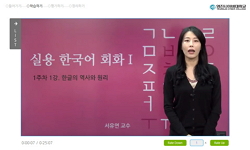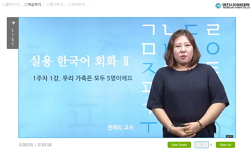The purpose of this study is to examine the redundant negation expressed in various forms in Korean and Chinese, and to identify commonalities and differences in the use of redundant negation in Korean and Chinese according to the structural and seman...
http://chineseinput.net/에서 pinyin(병음)방식으로 중국어를 변환할 수 있습니다.
변환된 중국어를 복사하여 사용하시면 됩니다.
- 中文 을 입력하시려면 zhongwen을 입력하시고 space를누르시면됩니다.
- 北京 을 입력하시려면 beijing을 입력하시고 space를 누르시면 됩니다.
부가정보
다국어 초록 (Multilingual Abstract)
The purpose of this study is to examine the redundant negation expressed in various forms in Korean and Chinese, and to identify commonalities and differences in the use of redundant negation in Korean and Chinese according to the structural and semantic characteristics of redundant negation. Redundant negation is a sentence in which a negative sign is used to represent an equivalent meaning to the affirmative statement, without expressing any negative meaning. The negative marker of redundant negation, which is a semantic redundant expression, is not a necessary condition of sentence semantic expression in the surface structure, but it is a necessary component in terms of phonetics or cognition because it expresses the subjective attitude or intention of the speaker by using negative form in the deep structure. Although there have been many studies on redundant negation in each language, the comparative study of the redundant negation in Korean and Chinese is still insufficient and it is merely mentioned in some discussions. Since the redundant negation is greatly influenced by the use of phonetic factors in use, the implementation method of Korean and Chinese is often different even if the same semantic expression is used in the same situation. Therefore, in order to accurately grasp the redundant negation, it is necessary to examine how the redundant negation appears in different languages. This paper examines the forms of redundant negation in Korean and Chinese according to their structural and semantic characteristics and analyzes their common and differences, and summarizes the characteristics of the use of redundant negation in Korean and Chinese. The research on the redundant negation is not only a part of the study on the negation category of Korean and Chinese, but it also has a significance in that it can provide the theoretical basis for the accurate use and understanding of the redundant negation to Chinese and Korean learners.
참고문헌 (Reference)
1 박진호, "허사 부정의 출현 환경" 2011
2 조소영, "한중 언어 전환에 나타나는 잉여 현상" 중국연구소 42 : 131-144, 2008
3 김송희, "한국어의 비전형적인 부정 구성 연구 : 상위언어적 부정 및 부정 아닌 부정을 중심으로" 서울대학교 대학원 2014
4 장유, "한․중 부정 의문문의 대조 연구" 연세대학교 2015
5 김순길, "중국인 학습자를 위한 한국어 잉여적 표현 고찰" 국제언어문학회 31 (31): 25-44, 2015
6 나찬연, "우리말 잉여표현 연구" 월인 2004
7 조준학, "영어와 한국어의 중복표현에 관한 화용적 고찰" 29 (29): 1993
8 윤재학, "부정어의 잉여성" 한국중원언어학회 (21) : 229-254, 2011
9 김동식, "부정 아닌 부정" 6 (6): 1981
10 김승곤, "물음법 씨끝 「-을까」의 형성에 대하여" 2 : 1996
1 박진호, "허사 부정의 출현 환경" 2011
2 조소영, "한중 언어 전환에 나타나는 잉여 현상" 중국연구소 42 : 131-144, 2008
3 김송희, "한국어의 비전형적인 부정 구성 연구 : 상위언어적 부정 및 부정 아닌 부정을 중심으로" 서울대학교 대학원 2014
4 장유, "한․중 부정 의문문의 대조 연구" 연세대학교 2015
5 김순길, "중국인 학습자를 위한 한국어 잉여적 표현 고찰" 국제언어문학회 31 (31): 25-44, 2015
6 나찬연, "우리말 잉여표현 연구" 월인 2004
7 조준학, "영어와 한국어의 중복표현에 관한 화용적 고찰" 29 (29): 1993
8 윤재학, "부정어의 잉여성" 한국중원언어학회 (21) : 229-254, 2011
9 김동식, "부정 아닌 부정" 6 (6): 1981
10 김승곤, "물음법 씨끝 「-을까」의 형성에 대하여" 2 : 1996
11 장석진, "국어의 부가 의문-형식과 기능-" 9 (9): 1984
12 최재희, "국어 중복 표현의 유형과 의미 구조의 특성" 36 : 2000
13 박종갑, "국어 의문문의 화용적 특성(2): 유형과 의미-‘-을까’유형의 의문문을 중심으로-" 3 : 1986
14 장경기, "국어 부정의문문과 전제" 22 (22): 1986
15 박정규, "국어 부정문의 체계적 연구" 보고사 2003
16 金龙军, "韩国语特殊否定表达研究" 上海外国语大学 2015
17 张谊生, "说“难免”——兼论汉语的虚化方式和羡餘否定" (9) : 1999
18 朱德熙, "说“差一點”" (9) : 1959
19 王灿龙, "说“VP之前”与“没(有)VP之前”" (5) : 2004
20 戴耀晶, "试说“冗餘否定”" (2) : 2004
21 戴耀晶, "试论现代汉语的否定范畴" (3) : 2000
22 石毓智, "肯定和否定的对称与不对称" 北京语言文化大学出版社 2001
23 曹婧一, "羡餘否定的语用认知分析" 首都师范大学 2007
24 石婧, "现代汉语羡餘否定现象研究" 吉林大学 2011
25 王进文, "现代汉语羡餘否定及其格式研究" 扬州大学 2008
26 王志英, "现代汉语特殊否定现象认知研究" 上海师范大学 2012
27 张谊生, "现代汉语副词研究" 商务印书馆 2014
28 张谊生, "现代汉语副词探索" 学林出版社 2004
29 杨子, "现代汉语冗餘否定的类型研究" 35 (35): 2015
30 钟书能, "汉语羡餘否定构式中的“没”真的是个羡餘标记吗?" 8 (8): 2015
31 刘丹青, "汉语研究的类型学视角" 北京语言大学出版社 2005
32 王助, "汉语否定羡餘词的特性" (3) : 2009
33 朱德熙, "汉语句法裡的歧义现象" (2) : 1980
34 袁毓林, "汉语反事实表达与相关的思维特點" 2016
35 江蓝生, "概念叠加與构式整合——肯定否定不对称的解释" (6) : 2008
36 石毓智, "对“差點兒”类羡餘否定句式的分化" (4) : 1993
37 时春晖, "基於标记理论的现代汉语羡餘否定现象研究" 北京外国语大学 1994
38 周一民, "北京话裡的“差點兒没VP”句式" (6) : 2003
39 袁毓林, "动词内隐性否定的语义层次和溢出条件" (2) : 2012
40 侯国金, "冗餘否定的语用条件——以“差一點+(没)V、小心+(别)V”为例" (5) : 2008
41 沈家煊, "不对称和标记论" 江西教育出版社 1999
42 邵静敏, "“非X不Y”及其变式" (1) : 1988
43 袁毓林, "“差點兒”中的隐性否定及其语法效应" 33 (33): 2013
44 沈家煊, "“好不”不对称用法的语义及语用解释" (4) : 1994
45 邹立志, "“好不A”诸现象的语义语用考察" (3) : 2006
46 장윤희(張允熙), "‘전(前)’의 內包文 構成의 文法史" 한국어문교육연구회 36 (36): 85-104, 2008
47 손세모돌, "‘-잖-’의 의미, 전제, 함축" 33 : 1999
48 Yoon SUwon, "Expletive negation in Japanese and Korean" 2008
동일학술지(권/호) 다른 논문
-
- 중국인문학회
- 김훈호
- 2016
- KCI등재
-
현대 상하이(上海) 지역의 언어사용 양상 변화에 대한 고찰
- 중국인문학회
- 강은지
- 2016
- KCI등재
-
중국 서적의 인용과 지식의 수용 - ≪오주연문장전산고(五洲衍文長箋散稿)≫를 중심으로
- 중국인문학회
- 박영순
- 2016
- KCI등재
-
중국 근대 대(對) 조선 서사 기록과 문학적 형상화 연구 - 황준헌(黃遵憲)ㆍ주가록(周家祿)ㆍ장건(張謇)의 중한관계 저작과 시문을 중심으로
- 중국인문학회
- 정해리
- 2016
- KCI등재
분석정보
인용정보 인용지수 설명보기
학술지 이력
| 연월일 | 이력구분 | 이력상세 | 등재구분 |
|---|---|---|---|
| 2024 | 평가예정 | 재인증평가 신청대상 (재인증) | |
| 2021-01-01 | 평가 | 등재학술지 선정 (계속평가) |  |
| 2020-12-01 | 평가 | 등재후보로 하락 (재인증) |  |
| 2017-01-01 | 평가 | 등재학술지 유지 (계속평가) |  |
| 2013-01-01 | 평가 | 등재학술지 유지 (등재유지) |  |
| 2010-01-01 | 평가 | 등재학술지 유지 (등재유지) |  |
| 2003-01-01 | 평가 | 등재후보학술지 선정 (신규평가) |  |
학술지 인용정보
| 기준연도 | WOS-KCI 통합IF(2년) | KCIF(2년) | KCIF(3년) |
|---|---|---|---|
| 2016 | 0.13 | 0.13 | 0.18 |
| KCIF(4년) | KCIF(5년) | 중심성지수(3년) | 즉시성지수 |
| 0.18 | 0.18 | 0.368 | 0.04 |





 KCI
KCI






